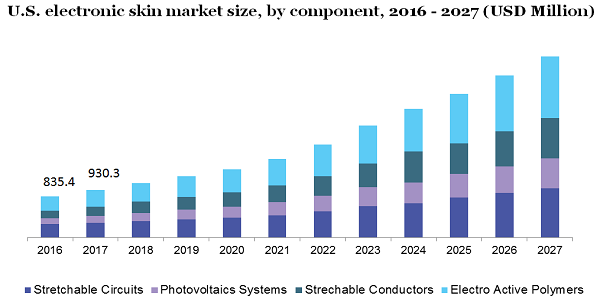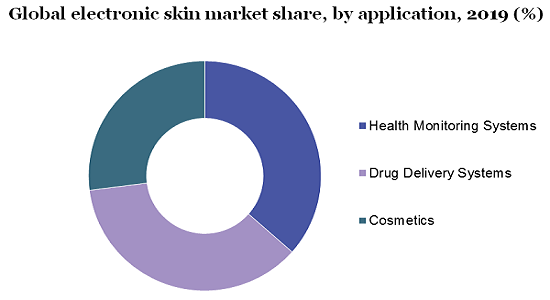- US: +1-408-610-2300
- Toll Free: +1-866-831-4085
- Become a Client
The global electronic skin market size was accounted for USD 4.5 billion in 2019. It is estimated to grow at a CAGR of 20.5% over the forecast period, 2020 to 2027. Electronic skins are widely used due to their benefits like flexibility, and self-healing capabilities. Artificial skin simulates humans sensing capabilities. Thus, this type of skin is useful in health monitoring solutions. In addition, supportive FDA approvals, and new product launches are also expected to boost the market growth. For example, in 2018, MC10 Inc., has received approval from the FDA for BioStamp point systems.

Wearable devices help in monitoring physical signals like tissue pressure, body motion, electrolyte balance, and temperature. Moreover, various benefits such as self-healing skins, sweating skin, and lightening electronic skin are projected to support the market growth.
The growing emphasis on R&D activities in artificial skin is projected to positively impact market growth. For example, in South Korea, the researcher has developed skin that senses pressure, sound, and temperature simultaneously. Additionally, scientists are doing research to mock tactile sensing, palate senses, and imitate olfactory. Further, increasing usage of skin in robotic devices, biomedical, and prosthetics are expected to offer growth opportunities for the market.
Technological advancements in artificial intelligence and 3D printing are boosting the growth in therapeutic practices, health monitoring, and drug delivery. In addition, the rising application of e-skin technology in cardiovascular, detecting abnormality, pregnancy, and diabetes is also contributing to the growth of the market.
Depending on the product, the electronic skin market is fragmented into electronic patches and electronic skinsuits. In 2019, the electronic patches segment led the market with the largest revenue share of 91.5% in the overall market. The skin patches include sensors, actuators for energy storage, communication, and processing. This technology helps to keep in contact with doctors without patients being in the hospital. These patches are widely used for motion sensing, self-monitoring, and temperature sensing.
The electronic suits type segment is anticipated to grow at the fastest growing CAGR from 2020 to 2027. Electronic suits are effective and are highly convenient in patent monitoring. The pressure & temperature sensors are used for obtaining feedback data which is needed in the monitoring process.
In 2019, the stretchable circuit division led the market with the highest share of over 30.0% in the overall market. These circuits offer a novel platform for regenerative medicines, robotic control by interfacing with soft tissues. Additionally, these circuits enable biosignals that can be measured on humans’ skin.
The electroactive polymers (EAP) component segment contributed to a significant market share. EAP polymers are electronic conductive and have high reversible storage capacity. These polymers can conform to different surfaces and also have low-moduli strain capabilities.
In 2019, electrophysiological sensors have led the market with the highest revenue share of approximately 40.0% in the global market. The increasing usage of sensors in healthcare applications including chronic disease and restoration therapies is attributing to the growth of this segment. In addition, sensors offer additional assistance in medical operations through telemedicine and telehealth.
The tactile sensor type segment is projected to expand at the fastest CAGR from 2020 to 2027. The increasing adoption of these technologies in physiological monitoring and robotic operation is boosting the segment growth. Additionally, technological developments in wearable devices are expected to bolster market growth. Moreover, rising R&D activities in tactile sensors such as flexible sensors provide high sensitivity.
The application segment is comprised of health monitoring systems, cosmetics, and drug delivery systems. In 2019, the health monitoring system segment held the largest share of 38.0% in the overall market. The growing product application in cardiology, neurology, and diabetes healthcare is boosting the market growth. The electronic patches are applied to the heart, brain, and muscle of patients.

The drug delivery system segment is estimated to expand at the highest CAGR over the forecast period. Various benefits such as real-time functioning in therapeutic operation and highly non-invasive features are driving the growth of this segment. These e-skins use muscle movement and make use of stored data for delivering medicines.
In 2019, North America led the market with the highest share of 39.0% in the global market. The growing aging population is boosting the new product launches in the e-skin field. Additionally, technological developments and supportive reimbursement policies are expected to proliferate market growth. Top players in the industry are present in the North American market, which are further attributing to regional growth.
Asia Pacific is estimated to grow at the highest CAGR over the forecast period. The rising number of diabetes patients and the aging population are mainly responsible for market growth. The aging population is increasing the need for an e-skin market. According to UNFPA data, one in every four people will be more than 60 years old by 2050 in the Asia Pacific market.
The outbreak of COVID-19 has positively impacted the global electronic skin market. The coronavirus crisis has led to several developments in the medical industry with a focus on monitoring patient's health status in real-time. Further, the companies have developed innovative electronic skin patches that can track patients’ heart rate and temperature. For instance, in Belgium, companies such as Quad Industries, Melexis, and Byteflies have collaborated to develop innovative e-skin patches for monitoring COVID-19 patients’ health.
These e-skin patches offer remote and continuous monitoring of a patient's respiration and body temperature levels. Thus, owing to these factors the market is anticipated to grow at a significant rate over the forecast period.
Leading players in the market are continuously focusing on developing new products with the help of technological innovations. For example, in 2018, Reckitt Benckiser and ViVaLNK have partnered to distribute wearable devices that provide temperature monitoring applications. Some of the products include Enfasmart FeverSense and Nurofen FeverSmart. These products help to monitor body temperatures and are approved by the FDA.
Key players in the market are engaged in integrating these devices with machine learning and artificial intelligence. Key participants include ViVaLNK, GENTAG Inc., Bloomlife, MC10, Xenoma, and DIALOG Semiconductors.
|
Attribute |
Details |
|
The market size value in 2020 |
USD 5.3 billion |
|
The revenue forecast in 2027 |
USD 19.6 billion |
|
Growth Rate |
CAGR of 20.5% from 2020 to 2027 |
|
The base year for estimation |
2019 |
|
Actual estimates/Historical data |
2016 - 2018 |
|
Forecast period |
2020 - 2027 |
|
Quantitative Units |
Revenue in USD Billions, & CAGR from 2020 to 2027 |
|
Report coverage |
Revenue forecast, company share, competitive landscape, growth factors, and trends |
|
Segments covered |
Product, component, sensors, application, region |
|
Regional scope |
North America, Europe, Asia Pacific, Latin America, and Middle East & Africa. |
|
Country scope |
The U.S.; Canada; Germany; The U.K.; France; Spain; Italy; Japan; China; India; South Korea; Australia; Brazil; Mexico; Argentina; Colombia; South Africa; Saudi Arabia; UAE. |
|
Key companies profiled |
MC10; Xenoma; VivaLNK; GENTAG, Inc.; DIALOG Semiconductors; Bloomlife. |
|
Customization scope |
Free report customization (equivalent up to 8 analysts working days) with purchase. Addition or alteration to country, regional & segment scope. |
|
Pricing and purchase options |
Avail of customized purchase options to meet your exact research needs. |
This report forecasts revenue growth at global, regional, and country levels and provides an analysis of the latest industry trends and opportunities in each of the sub-segments from 2020 to 2027. For the purpose of this study, Million Insights has segmented the global electronic skin market report on the basis of product, Component, Sensors, Application, and region:
• Product Outlook (Revenue, USD Billion, 2016 - 2027)
• Electronic skinsuits
• Electronic patches
• Component Outlook (Revenue, USD Billion, 2016 - 2027)
• Stretchable circuits
• Photovoltaics systems
• Stretchable Conductors
• Electroactive polymers
• Sensors Outlook (Revenue, USD Billion, 2016 - 2027)
• Tactile sensors
• Chemical sensors
• Electrophysiological sensors
• Others
• Application Outlook (Revenue, USD Billion, 2016 - 2027)
• Health monitoring systems
• Drug delivery systems
• Cosmetics
• Regional Outlook (Revenue, USD Billion, 2016 - 2027)
• North America
• U.S.
• Canada
• Europe
• U.K.
• Germany
• France
• Italy
• Spain
• The Asia Pacific
• Japan
• China
• India
• South Korea
• Australia
• Latin America
• Brazil
• Mexico
• Argentina
• Colombia
• Middle East & Africa (MEA)
• South Africa
• Saudi Arabia
• UAE


Research Support Specialist, USA